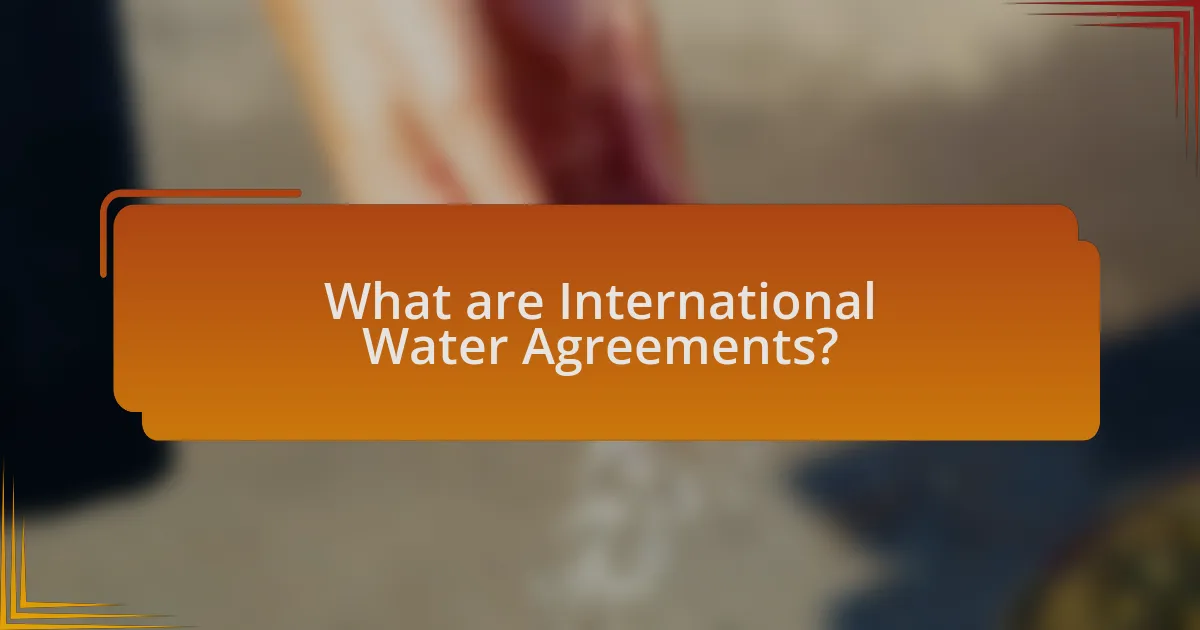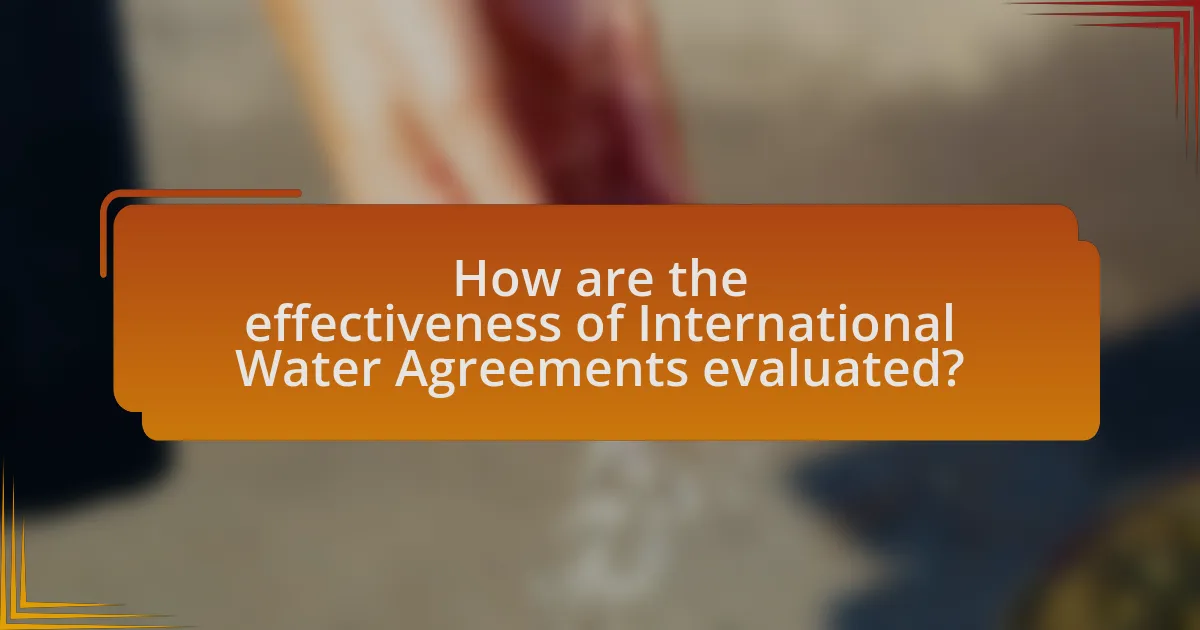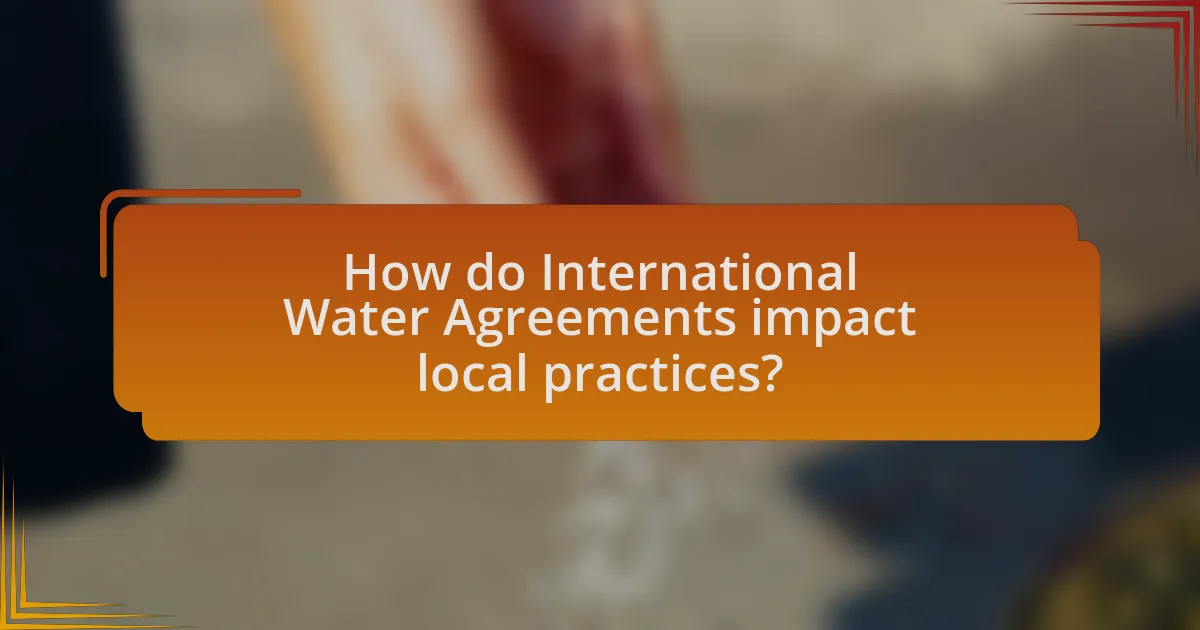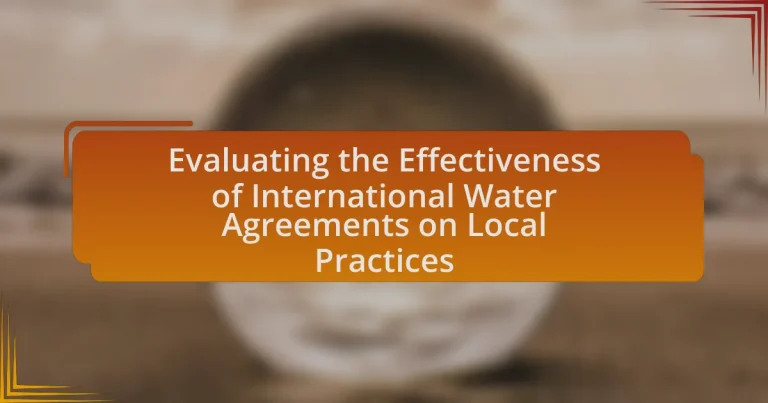International Water Agreements are legally binding treaties that regulate the management and use of shared water resources among countries. This article evaluates the effectiveness of these agreements on local practices, highlighting their role in promoting cooperation, preventing conflicts, and ensuring sustainable water use. Key components such as water rights, dispute resolution mechanisms, and environmental protection measures are discussed, along with their influence on local governance and community engagement. The article also examines the challenges in evaluating these agreements, the impact of political and economic factors, and best practices for enhancing their effectiveness at the local level. Additionally, it explores future directions for improving these agreements in response to emerging water challenges.
What are International Water Agreements?

International Water Agreements are legally binding treaties or accords between countries that govern the management and use of shared water resources. These agreements aim to promote cooperation, prevent conflicts, and ensure sustainable water use among nations that share rivers, lakes, or aquifers. For instance, the 1997 United Nations Convention on the Law of the Non-Navigational Uses of International Watercourses establishes principles for the equitable and reasonable utilization of shared watercourses, highlighting the importance of cooperation and data sharing among states.
How do International Water Agreements function?
International water agreements function by establishing legally binding frameworks for the management and allocation of shared water resources between countries. These agreements typically outline the rights and responsibilities of each party, mechanisms for dispute resolution, and protocols for data sharing and monitoring water quality and quantity. For instance, the 1997 United Nations Convention on the Law of the Non-Navigational Uses of International Watercourses provides guidelines for equitable and reasonable utilization of shared water resources, emphasizing cooperation among states. Such agreements are crucial for preventing conflicts, promoting sustainable water use, and ensuring that local practices align with international standards for water management.
What are the key components of International Water Agreements?
The key components of International Water Agreements include the definition of water rights, allocation of water resources, management of transboundary watercourses, dispute resolution mechanisms, and environmental protection measures. These components ensure equitable access to water, promote sustainable management practices, and facilitate cooperation among nations sharing water resources. For instance, the 1997 United Nations Convention on the Law of the Non-Navigational Uses of International Watercourses emphasizes the importance of equitable and reasonable utilization of shared water resources, highlighting the necessity of cooperation and information exchange among states.
How do these components influence local water management practices?
Components such as international water agreements, local governance structures, and community engagement significantly influence local water management practices. International water agreements establish legal frameworks and guidelines that local authorities must follow, ensuring compliance with broader environmental and resource management goals. Local governance structures determine how effectively these agreements are implemented, as they dictate the allocation of resources and responsibilities among various stakeholders. Community engagement fosters collaboration and ensures that local needs and knowledge are integrated into water management strategies, enhancing the effectiveness of the agreements. For instance, the United Nations Watercourses Convention promotes cooperative management of transboundary water resources, which local authorities can adapt to their specific contexts, thereby improving local water management outcomes.
Why are International Water Agreements important?
International Water Agreements are important because they facilitate cooperation among countries sharing water resources, ensuring sustainable management and equitable distribution. These agreements help prevent conflicts over water scarcity, promote joint management of transboundary water bodies, and establish frameworks for addressing pollution and conservation. For instance, the 1997 United Nations Convention on the Law of Non-Navigational Uses of International Watercourses provides guidelines for states to cooperate on shared water resources, highlighting the necessity of collaboration in managing water effectively.
What role do they play in transboundary water resource management?
International water agreements play a crucial role in transboundary water resource management by establishing frameworks for cooperation among countries sharing water resources. These agreements facilitate the equitable distribution of water, promote sustainable management practices, and help prevent conflicts over water usage. For instance, the 1997 United Nations Convention on the Law of Non-Navigational Uses of International Watercourses provides guidelines for states to cooperate in managing shared water resources, emphasizing the need for prior notification and consultation on projects that may affect other states. This legal framework supports collaborative efforts, ensuring that all parties have a voice in decision-making processes related to water management.
How do they contribute to sustainable development goals?
International water agreements contribute to sustainable development goals by promoting equitable access to water resources, ensuring environmental sustainability, and fostering cooperation among nations. These agreements facilitate the sharing of best practices and technologies, which can lead to improved water management and conservation efforts. For instance, the United Nations recognizes that effective water governance is essential for achieving Goal 6, which aims to ensure availability and sustainable management of water and sanitation for all. Additionally, collaborative frameworks established by these agreements can help mitigate conflicts over water resources, thereby supporting peace and stability, which aligns with Goal 16 focused on promoting peaceful and inclusive societies.
How are the effectiveness of International Water Agreements evaluated?

The effectiveness of International Water Agreements is evaluated through a combination of quantitative and qualitative assessments, including compliance monitoring, impact assessments, and stakeholder feedback. Compliance monitoring involves tracking the adherence of countries to the terms of the agreements, often using indicators such as water quality and quantity metrics. Impact assessments analyze the agreements’ outcomes on local water management practices, ecosystem health, and community livelihoods. Stakeholder feedback, including input from local communities and water management authorities, provides insights into the practical implications of the agreements. These methods collectively help determine whether the agreements achieve their intended goals and foster sustainable water resource management.
What criteria are used to assess the effectiveness of these agreements?
The criteria used to assess the effectiveness of international water agreements include compliance with terms, the sustainability of water resources, and the impact on local communities. Compliance with terms evaluates whether the parties adhere to the agreed-upon regulations and commitments, which is essential for maintaining trust and cooperation. Sustainability of water resources examines whether the agreements lead to the long-term preservation and equitable distribution of water, ensuring that future generations can also benefit. The impact on local communities assesses how these agreements affect the livelihoods, health, and socio-economic conditions of the populations relying on the water resources, highlighting the agreements’ relevance to local practices.
How do stakeholder perspectives influence the evaluation process?
Stakeholder perspectives significantly influence the evaluation process by shaping the criteria and priorities used to assess effectiveness. Different stakeholders, such as local communities, governments, and NGOs, bring unique values and interests that affect how success is defined and measured. For instance, local communities may prioritize access to clean water, while governments might focus on compliance with international agreements. This divergence in priorities can lead to varying interpretations of what constitutes effective implementation. Research indicates that stakeholder engagement in evaluation processes enhances the relevance and accuracy of assessments, as seen in studies like “Stakeholder Engagement in Evaluation: A Review of the Literature” by Cousins and Chouinard, which highlights the importance of incorporating diverse viewpoints to achieve comprehensive evaluations.
What methodologies are commonly employed in these evaluations?
Common methodologies employed in evaluating the effectiveness of international water agreements on local practices include qualitative analysis, quantitative analysis, case studies, and comparative assessments. Qualitative analysis often involves interviews and focus groups to gather insights from stakeholders, while quantitative analysis utilizes statistical methods to assess data related to water usage and compliance. Case studies provide in-depth examinations of specific agreements and their impacts on local practices, and comparative assessments analyze different agreements across various regions to identify best practices and outcomes. These methodologies collectively enable a comprehensive understanding of how international agreements influence local water management.
What challenges exist in evaluating the effectiveness of International Water Agreements?
Evaluating the effectiveness of International Water Agreements faces several challenges, including the complexity of transboundary water management, differing national interests, and the lack of comprehensive data. The complexity arises from the diverse legal, political, and environmental contexts in which these agreements operate, making it difficult to assess their impact uniformly. Differing national interests can lead to conflicting priorities, where countries may prioritize their own water needs over collective goals, complicating the evaluation process. Additionally, the lack of comprehensive data on water usage, quality, and ecosystem health hinders the ability to measure the outcomes of these agreements effectively. These factors collectively contribute to the challenges in determining the success and effectiveness of International Water Agreements.
How do political and economic factors impact evaluation outcomes?
Political and economic factors significantly influence evaluation outcomes by shaping the context in which international water agreements are assessed. Political stability, governance quality, and the presence of supportive policies can enhance the effectiveness of these agreements, leading to more favorable evaluation results. Conversely, political instability or lack of commitment can hinder implementation and skew evaluations negatively. Economically, the availability of resources, funding, and investment in infrastructure directly affect the success of water agreements, as evidenced by studies showing that countries with stronger economies tend to achieve better compliance and outcomes in water management initiatives. For instance, the World Bank has reported that nations with robust economic frameworks are more likely to implement effective water governance, thereby improving evaluation outcomes.
What are the limitations of current evaluation frameworks?
Current evaluation frameworks for assessing the effectiveness of international water agreements on local practices face several limitations. These frameworks often lack comprehensive metrics that capture the multifaceted nature of water governance, leading to an incomplete understanding of outcomes. For instance, many frameworks prioritize quantitative data over qualitative insights, which can overlook local context and stakeholder perspectives. Additionally, existing frameworks may not adequately account for the dynamic interactions between various governance levels, resulting in a fragmented view of effectiveness. Research by the Global Water Partnership highlights that many frameworks fail to incorporate adaptive management principles, which are essential for responding to changing environmental and social conditions.
How do International Water Agreements impact local practices?

International water agreements significantly influence local practices by establishing frameworks for water resource management, conflict resolution, and cooperative governance among nations sharing water bodies. These agreements often lead to the implementation of sustainable practices at the local level, as they encourage countries to adopt shared standards and regulations that promote equitable water distribution and environmental protection. For instance, the 1997 United Nations Convention on the Law of the Non-Navigational Uses of International Watercourses has been instrumental in guiding countries to develop local policies that align with international norms, thereby enhancing local water management strategies and fostering collaboration among communities.
What changes in local water management practices can be attributed to these agreements?
Local water management practices have shifted towards more collaborative and sustainable approaches due to international water agreements. These agreements often promote integrated water resource management (IWRM), which encourages stakeholder participation and considers the entire watershed. For instance, the 1997 United Nations Watercourses Convention has led to countries adopting joint management frameworks, resulting in improved water quality and equitable distribution. Additionally, agreements have facilitated the sharing of technology and best practices, enhancing local capacities for water conservation and pollution control.
How do local communities perceive the influence of International Water Agreements?
Local communities often perceive the influence of International Water Agreements as both beneficial and challenging. These agreements are seen as essential for promoting cooperation among nations, ensuring equitable water distribution, and addressing transboundary water issues. However, communities frequently express concerns about the lack of local representation in the negotiation processes, which can lead to decisions that do not align with their specific needs or priorities. For instance, a study by the International Water Management Institute highlights that local stakeholders often feel marginalized, resulting in a disconnect between international policies and local water management practices. This perception underscores the importance of integrating local voices into the formulation and implementation of such agreements to enhance their effectiveness and acceptance.
What are the observable outcomes in water quality and availability?
Observable outcomes in water quality and availability include improved access to clean drinking water and reduced levels of pollutants in water bodies. For instance, the implementation of international water agreements has led to a significant decrease in contaminants such as nitrates and phosphates in rivers, enhancing the overall quality of water. According to a study published in the Journal of Water Resources Planning and Management, regions that adopted collaborative water management practices under international agreements reported a 30% reduction in waterborne diseases, indicating better water quality and availability.
What best practices can enhance the effectiveness of International Water Agreements at the local level?
Best practices that can enhance the effectiveness of International Water Agreements at the local level include stakeholder engagement, capacity building, and adaptive management. Stakeholder engagement ensures that local communities are involved in decision-making processes, which fosters ownership and compliance with agreements. Capacity building equips local authorities and communities with the necessary skills and knowledge to implement water management practices effectively. Adaptive management allows for the continuous assessment and adjustment of strategies based on changing conditions and feedback, ensuring that agreements remain relevant and effective. These practices are supported by evidence from various case studies, such as the success of the Mekong River Commission, which emphasizes local participation and adaptive strategies in its governance framework.
How can local governance structures be aligned with international agreements?
Local governance structures can be aligned with international agreements by integrating the principles and objectives of these agreements into local policies and regulations. This alignment can be achieved through the establishment of frameworks that facilitate collaboration between local authorities and international bodies, ensuring that local governance reflects the commitments made at the international level. For instance, the United Nations Sustainable Development Goals (SDGs) encourage local governments to adopt sustainable practices that correspond with global targets, thereby promoting coherence between local actions and international commitments. Additionally, capacity-building initiatives can empower local officials to understand and implement international agreements effectively, ensuring that local governance is not only compliant but also proactive in addressing global challenges such as water management.
What role does community engagement play in implementing these agreements?
Community engagement is crucial in implementing international water agreements as it fosters local ownership and accountability. Engaged communities are more likely to understand the agreements’ objectives, leading to better compliance and sustainable practices. Research indicates that when local stakeholders participate in decision-making processes, the effectiveness of water management increases significantly, as seen in case studies from the United Nations Environment Programme, which highlight that inclusive approaches enhance the success of water governance initiatives.
What are the future directions for improving International Water Agreements?
Future directions for improving International Water Agreements include enhancing stakeholder participation, integrating climate change considerations, and adopting adaptive management practices. Enhancing stakeholder participation ensures that local communities and affected parties have a voice in decision-making, which can lead to more equitable and effective agreements. Integrating climate change considerations is crucial, as water availability and quality are increasingly impacted by climate variability; agreements must be flexible enough to adapt to these changes. Adopting adaptive management practices allows for ongoing assessment and modification of agreements based on new data and changing conditions, ensuring that they remain relevant and effective over time. These approaches are supported by studies indicating that inclusive and adaptive frameworks lead to more sustainable water management outcomes.
How can technology be leveraged to enhance compliance and monitoring?
Technology can be leveraged to enhance compliance and monitoring by utilizing data analytics, remote sensing, and blockchain systems. Data analytics allows for real-time tracking of water usage and quality, enabling authorities to identify non-compliance swiftly. Remote sensing technologies, such as satellite imagery, provide comprehensive monitoring of water bodies, ensuring adherence to international agreements. Blockchain systems enhance transparency and traceability in water management, allowing stakeholders to verify compliance with established regulations. These technological applications have been shown to improve accountability and facilitate timely interventions, thereby reinforcing the effectiveness of international water agreements in local practices.
What innovative approaches can be adopted to address emerging water challenges?
Innovative approaches to address emerging water challenges include the implementation of integrated water resource management (IWRM), which promotes the coordinated development and management of water, land, and related resources. IWRM has been recognized by the United Nations as essential for sustainable development, as it helps balance social, economic, and environmental objectives. Additionally, the adoption of advanced technologies such as smart water management systems, which utilize real-time data and analytics, can enhance water efficiency and reduce waste. For instance, the use of satellite imagery and remote sensing has been shown to improve irrigation practices and water allocation in agriculture, leading to significant water savings. Furthermore, community-based water management initiatives empower local stakeholders to participate in decision-making, fostering resilience and adaptability to changing water conditions. These approaches collectively contribute to more effective responses to water scarcity and quality issues, aligning with the goals of international water agreements.


